Dawn of the Space Age
Contemporary Events
- 1957: the Soviet Union launched the first satellite into orbit. This marks the onset of “The Space Age”.
- 1960: President Kennedy vows that the United States would reach the moon by 1970. 1969 saw the first manned moon landing.
- Between 1957 and 1969: the previous “Silent Generation” was replaced by a louder, opinionated, questioning group of young people. Various groups of youth become marked by identifiable patterns of dress. “Style Tribes” become very apparent. Examples of these “tribes” are Beatniks, Hippies, and Mods, etc. Many of these groups will champion causes through protest and demonstration. These causes included opposition to the brewing Vietnam War, Women’s Liberation, Civil Rights, Environmental Preservation, etc. Activism was prolific among college students.
Women: 1954-1964
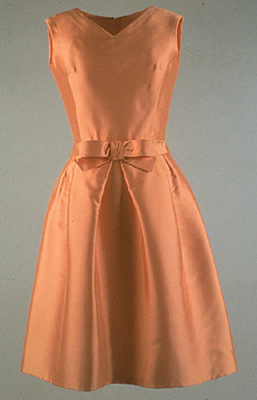
A dress from Jackie Kennedy’s wardrobe
Designer Oleg Cassini is most identified with the wardrobe of Jackie Kennedy. Before her husband was elected President of the United States, Mrs. Kennedy had a full couture wardrobe filled with the likes of Balenciaga and Givenchy. As her husband’s political career headed toward the White House, Jackie took it upon herself to interview American designers clamoring to become her stylist. She chose Cassini and made it a point to wear his clothes almost exclusively to all publicized events that she attended. Cassini was known for a sleek minimalism. Through Mrs. Kennedy, Cassini became a powerful figure in 1960s style offering a youthful, smooth modernity–a stark contrast to the lines of the prevailing New Look. He specialized in A-line dresses and suits/ensembles that were generally only slightly shaped though the upper torso. The left image above is of one of his dresses designed for and worn by the first lady.
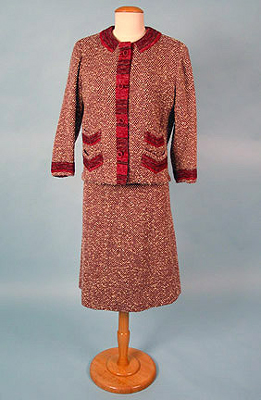 When Gabrielle “Coco” Chanel reopened her atelier in 1954, she immediately resumed her place as a major force in couture fashion. Employing some of the same ideas as Cassini, her designs also help to shape the 1960s. The Chanel suit was a direct reaction to Dior’s New Look. The suit feaured a straight skirt with an almost shapeless cardigan style jacket. She favored nubby wools and tweeds and acheived her desired fit through manipulation of the material rather than darts and seams. The style is practically timeless, and flattered nearly every body type–an appealing trait to the older woman during the 1950s.
When Gabrielle “Coco” Chanel reopened her atelier in 1954, she immediately resumed her place as a major force in couture fashion. Employing some of the same ideas as Cassini, her designs also help to shape the 1960s. The Chanel suit was a direct reaction to Dior’s New Look. The suit feaured a straight skirt with an almost shapeless cardigan style jacket. She favored nubby wools and tweeds and acheived her desired fit through manipulation of the material rather than darts and seams. The style is practically timeless, and flattered nearly every body type–an appealing trait to the older woman during the 1950s.
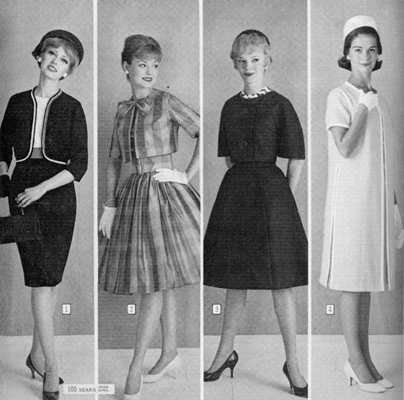 The New Look silhouette is the prevailing silhouette through the end of the 1950s. However, beginning late in the decade the new styles of Cassini, Chanel and others coexist with the Dior-inspired lines. The new alternatives sort of layer on top of the predominant styles.
The New Look silhouette is the prevailing silhouette through the end of the 1950s. However, beginning late in the decade the new styles of Cassini, Chanel and others coexist with the Dior-inspired lines. The new alternatives sort of layer on top of the predominant styles.
As we move towards the mid 60s, skirt lengths gradually shorten, and the overall silhouette relaxes. The new silhouette is straight and unfitted or princess cut. A slight A-line in which the waist was loosely defined is also typical. By 1964, this new silhouette becomes the most common line.
Women’s suits seem to take to the newer, looser silhouette the most quickly and universally. It is a very short time before garments inspired by the big designers appear in read-to-wear catalogs (such as the one from which the the image at the left was taken). At the far left, we see a Chanel-inspired suit. At the far right, we see a Cassini-inspired jacket and skimmer ensemble.
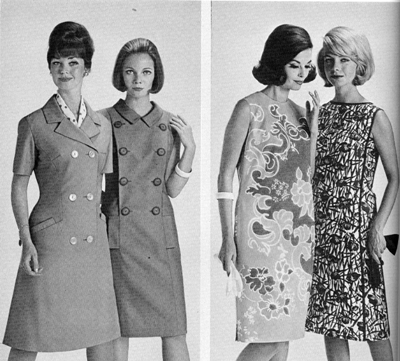
Skimmer and Sheath dresses
The skimmer was a sleeveless, princess line style that was a popular example of the new silhouette. The dresses pictured at the right are examples of this cut. Bold prints often added interest to the simplified line.
Hair styles inflate in size during this period of time. Women utilize back-combing, rats, and clip-on hair additions to create sleek, semi-architectural bouffant styles.
More women chose to go hatless as a result of the voluminous hairdos. Those hats that were worn included many with large crowns and brims on the smaller side if not missing altogether. Jacqueline Kennedy wore apillbox (as seen on the women pictured at the far right above) designed by Halston to her husband’s presidential inauguration in 1961. This style was then, of course, copied by many women.
While the actual practice of wearing hats declined, women will continue to wear them for formal, dressy occasions such as attending church.
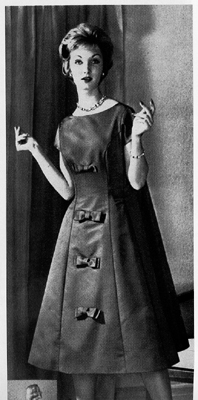
Trapeze Dress
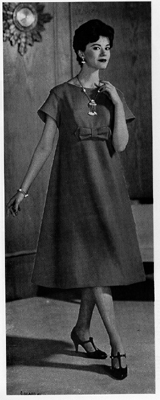
Trapeze Dress
Starting around 1960 there is a pseudo revival of the empire waistline. It is most often seen in the trapeze dress which also featured a full A-line skirt (two variations of this style are shown here).
Due to advances in technology, it became possible to make nylon stockings that fit the leg smoothly and without wrinkles. As a result, stockings without seams become popular. Also pantyhose was introduced in 1960. Since this new hosiery item essentially combined panties and stockings (thus the name), the use of garters and garterbelts declined.
Starting in the mid-1950s, toes of shoes grew more and more pointed while the heels grew narrower. Stilhetto heels were so narrow that it was necessary to embed a steel spike in the center of the heel in order to keep it from snapping.
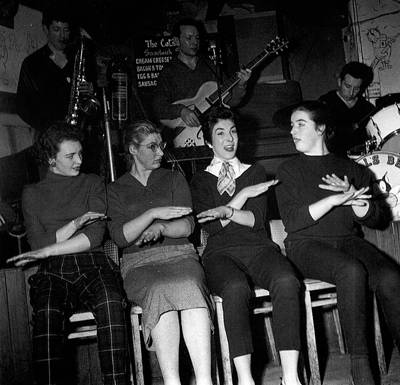

In the early 1960s, knitted stretch pants with narrow legs were worn with straight, bloused, or knitted tops. While still retaining standard construction details–ie. a waistband, fly placket, pockets– these pants were so narrow that they hugged the leg (aided by stretch knits) and generally had a stirrup strap passing under the instep of the foot.
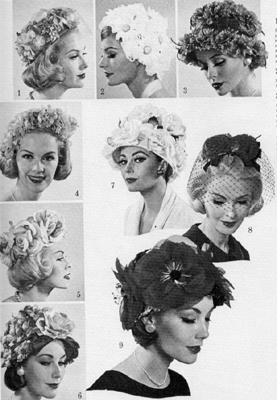 Despite the decline in the wearing of hats, some really fun and silly hat styles were available. Hats take on a humor and boldness that has its roots in the early 1950s. By the late 1950s, hats are frivolous, sassy, and a bit over the top.
Despite the decline in the wearing of hats, some really fun and silly hat styles were available. Hats take on a humor and boldness that has its roots in the early 1950s. By the late 1950s, hats are frivolous, sassy, and a bit over the top.
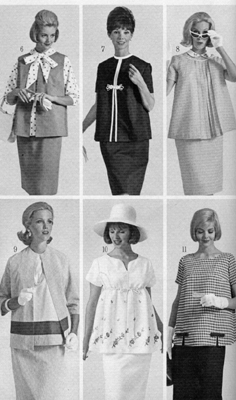
Maternity Styles are now advertised openly for women. However, the women modeling were not pregnant.
Thanks to Lucille Ball’s television show I LOVE LUCY, maternity wear becomes another fashionable addition to a woman’s wardrobe. Lucy was the first TV housewife to write her real-life pregnancy into ther program. Initially this was received as radical and scandalous, but American women took her example as an invitation to celebrate their own pregnancies through fashion. Advertisements for maternity clothing suddenly appear in magazines and cataolgs. Notice, however, that these maternity styles are being modeled on non-pregnant women. This was a common trend of the period.
Recent Comments